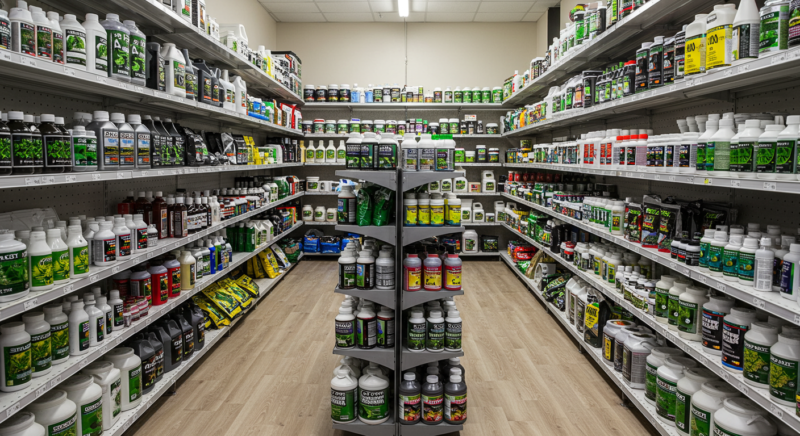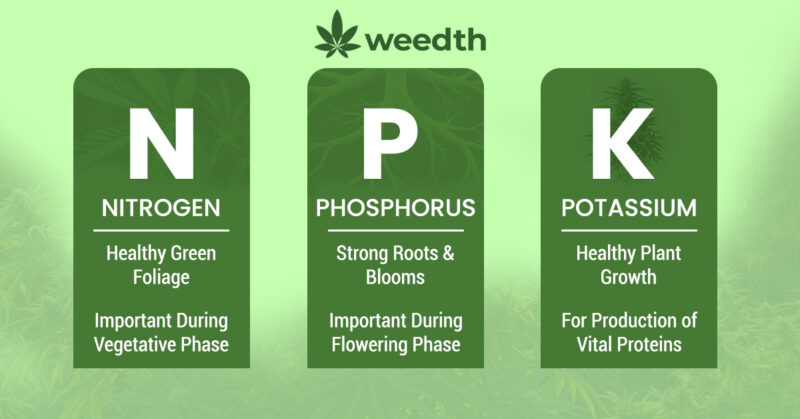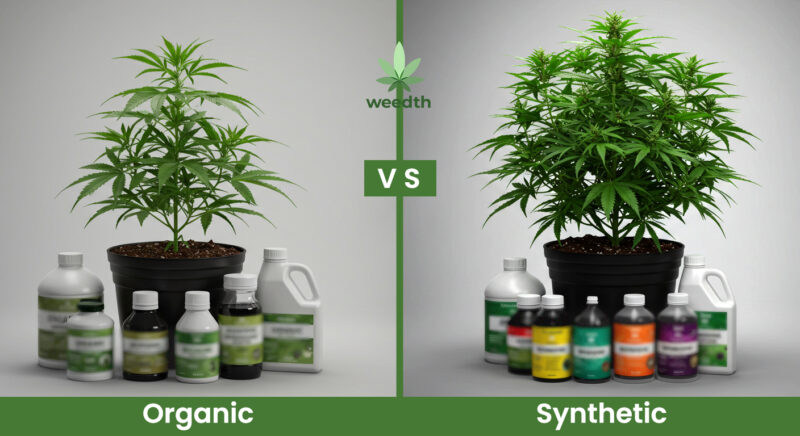Nutrient Management

Nutrient management is crucial for the healthy growth and high yields of cannabis plants. Just as humans need a balanced diet, cannabis plants require a precise mix of essential nutrients throughout their life cycle. These nutrients support various processes like growth, photosynthesis, and bud development. Understanding how to supply these nutrients, when to adjust their amounts, and how to maintain soil health can make all the difference in achieving a successful harvest.
Essential Nutrients

Cannabis plants rely on a range of nutrients to grow with a primary distinction between macronutrients and micronutrients. Macronutrients are needed in larger quantities, while micronutrients though still essential but they are required in smaller amounts.
Macronutrients: Nitrogen (N), Phosphorus (P), Potassium (K)
Macronutrients are required in larger quantities than micronutrients and are vital for the primary growth processes of the plant. The three primary macronutrients are nitrogen (N), phosphorus (P), and potassium (K), often referred to collectively as NPK.
- Nitrogen (N) is essential for vegetative growth. It is a key component of chlorophyll, the molecule responsible for photosynthesis, and is also involved in synthesizing amino acids, proteins and other important cellular structures. A nitrogen-rich diet supports the development of lush, green foliage during the vegetative stage.
- Phosphorus (P) plays a crucial role in energy transfer within the plant, particularly in the formation of ATP, the energy currency of cells. Phosphorus is also vital for root development and flowering. During the flowering stage, cannabis plants require higher levels of phosphorus to support the production of buds.
- Potassium (K) is important for regulating water and nutrient transport within the plant. It also strengthens the plant’s immune system, helping it to resist diseases and stress. Potassium supports overall plant health and is particularly important for developing dense and resinous buds during flowering stage.

Micronutrients: Calcium, Magnesium, Iron, etc.
While required in smaller quantities, micronutrients are no less important than macronutrients. They play specialized roles in various biochemical and physiological processes within the plant.
- Calcium is critical for cell wall formation and stability. It also aids in root development and helps regulate nutrient uptake. Calcium deficiencies can lead to issues like stunted growth and weakened cell walls, making the plant more susceptible to disease.
- Magnesium is the central atom in the chlorophyll molecule, making it essential for photosynthesis. It also plays a role in enzyme activation and nutrient transport. Magnesium deficiency often manifests as yellowing between the veins of leaves which is known as chlorosis.
- Iron is involved in the production of chlorophyll and is crucial for energy transfer within the plant. Iron deficiencies can result in poor growth and yellowing leaves, particularly in younger leaves.
Other important micronutrients include sulfur, zinc, manganese, and boron, each playing a role in various plant functions, from enzyme activation to hormone regulation.
Nutrient Schedules

Feeding schedules are critical in ensuring that cannabis plants receive the right nutrients at the right times. The nutrient requirements of cannabis change as the plant progresses through its growth stages, and feeding schedules should be adjusted accordingly to meet these evolving needs.
Feeding Schedules for Different Growth Stages
- Seedling Stage: During the seedling stage, cannabis plants are delicate and do not require large amounts of nutrients. A light, balanced nutrient solution is typically sufficient, as seedlings are more prone to nutrient burn. Many growers prefer to start with a nutrient-free medium and gradually introduce a weak solution once the first set of true leaves has developed.
- Vegetative Stage: Its demand for nutrients, particularly nitrogen, increases significantly. Nitrogen is vital for the development of stems and leaves, supporting the rapid growth characteristic of this stage. A higher NPK ratio with more nitrogen is typically used during this phase. Feeding should be more frequent, often every other watering, depending on the growing medium and environmental conditions.
- Flowering Stage: During the flowering stage, the plant’s nutrient needs shift. Phosphorus and potassium become more important as they support bud formation and resin production. A flowering nutrient mix will typically have a lower nitrogen content and higher levels of phosphorus and potassium. Feeding schedules during this stage should be adjusted to avoid over-fertilization, which can negatively impact bud development and flavor.
Organic vs. Synthetic Fertilizers

An important consideration for cannabis growers is choosing between organic or synthetic fertilizers. Organic fertilizers made from natural sources such as compost, bone meal, or fish emulsion, provide a slow-release form of nutrients that improves long-term soil health. They help build a living soil ecosystem that encourages beneficial microorganisms, which in turn promote nutrient uptake and protect against pathogens.
Synthetic fertilizers provide nutrients in a more readily available form. This allows for faster results and greater control over nutrient levels. While synthetic fertilizers can lead to quicker growth, they may not contribute to long-term soil health in the same way organic options do. Additionally, be careful that synthetic nutrients can result in salt buildup in the soil, potentially leading to nutrient lockout.
The choice between organic and synthetic fertilizers often depends on the grower’s goals. Organic fertilizers create a more sustainable and balanced growing environment, while synthetic options offer precision and immediate results.



